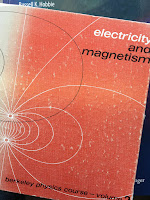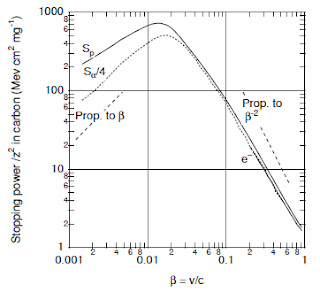 |
| Electricity and Magnetism, by Edward Purcell. |
The most relativisticish equation we present is in Chapter 15 when analyzing how charged particles (such as protons, electrons, or alpha particles) lose energy when passing through tissue at relativistic speeds. We write
The stopping powers are plotted vs particle speed in the form β = v/c. At low energies (β ≪ 1) β is related to kinetic energy by
For larger values of β, the relativistically correct expression
was used to convert Fig. 15.17 to 15.18.
Fig. 15.17
Fig. 15.18
Here’s a new homework problem examining the relationship between a particle’s speed and kinetic energy when its speed is near the speed of light.
Section 15.11
Problem 41 ½. A charged particle’s kinetic energy, T, is related to its mass M and its speed, v. We often express speed in terms of the parameter β = v/c, where c is the speed of light.
(a) At low energies (T ≪ Mc2, or equivalently β ≪ 1), show that Eq. 15.47 is consistent with the familiar expression from classical mechanics, T = ½ mv2.
(b) Show that Equation 15.48 (the relativistically correct relationship between β and T) reduces to Eq. 15.47 when T ≪ Mc2.
(c) Plot β versus T/Mc2, both in a linear plot (0 < T/Mc2 < 3) and in a log-log plot (0.0001 < T/Mc2 < 100).
(d) Take a few data points from Fig. 15.17 for a proton, replot them in Fig. 15.18, where the dependent variable is β, not T. See how well they match. Be sure to adjust for the different units for Stopping Power in the two plots.







No comments:
Post a Comment